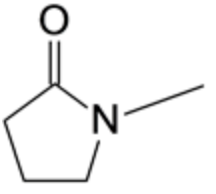Question
In: Chemistry
N-Methyl-2-pyrrolidone is an aprotic solvent used in many industrial processes. Draw the structure of the product formed when it is heated with strong aqueous acid 6MHCI, H20 and heat.
N-Methyl-2-pyrrolidone is an aprotic solvent used in many industrial processes. Draw the structure of the product formed when it is heated with strong aqueous acid 6MHCI, H20 and heat.
Solutions
Expert Solution
Concepts and reason
This problem is based on the concept of the reaction of \(\mathrm{N}\) -methyl- 2 -pyrrolidone. N-methyl-2-pyrrolidone is an organic compound that consists of a five-membered lactam. It is called NMP as short. It is a beneficial compound that is used to recover hydrocarbons generated during the processing of petrochemicals.
Fundamentals
N-methyl-2-pyrrolidone is a very reactive compound. It reacts in an acidic medium to form a variety of products. Some reactions involve the ring-opening step.
The structure of N-methyl-2-pyrrolidone is given below:

The compound has a five-membered ring, which consists of four carbon atoms and one nitrogen atom. The ring has one oxygen attached to it via the double bond, and one methyl group is attached to the nitrogen atom.
The chemical reaction involved is as follows:

The structure of the product is given below:

N-methyl-2-pyrrolidone on reaction with strong aqueous acidic medium followed by the treatment of heat results in the opening of the ring and forms a compound having a carboxylic group at one end and protonated nitrogen atom which has one methyl group attached to it, at another end.
The structure of the product is given below:

Related Solutions
Butanone, when treated with methyl magnesium bromide and thendilute aqueous acid, yields 2-methyl-2-butanol.a) Please...
draw full sn1 mechanism for a reaction that includes 2-methyl-2-propanol, n-pentanol and hydrochloric acid as the...
1) Draw the structure of the product formed by addition of vitamin B1 and benzaldehyde. 2)...
1) Draw the structure of the product formed by addition of vitamin B1 and benzaldehyde. 2)...
1)When optically active (R)-2- methyl cyclohexanone is treated with aqueous acid , its optical activity is...
- What artifacts, espoused values, enacted values and norms, and assumptions demonstrate the culture of Southwest Airlines?
- 1) 10000 lb/h of a 40.00% NaoH solution is crystallized through a combined evaporator-crystallizer process. The...
- STRICT DOWNVOTE IF NOT DONE FULLY, WILL REPORT ALSO IF COPY PASTED OR MODIFIED ANSWER Develop...
- The three questions are basically looking for an observation, asking the question and then giving the...
- YOU are the financial officer at an Austrian company that wants to BUY USD 1.000.000 of...
- Please read the whole program (all the way to the bottom), Thanks in advance! Develop car...
- A)Consider the following gases, all at STP: Ne, SF6, N2, CH4. Which gas is most likely...
 Dr. OWL answered 4 years ago
Dr. OWL answered 4 years ago